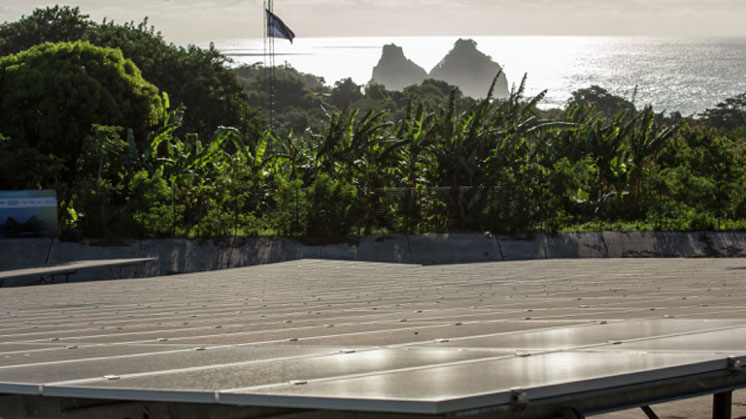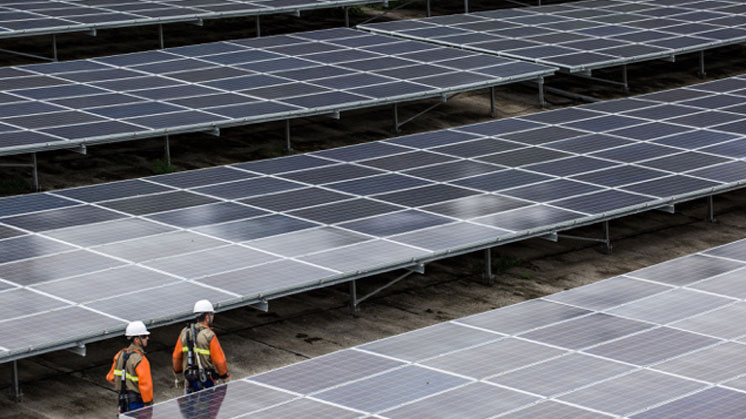Fernando de Noronha
Fernando de Noronha: commitment to sustainability
This island, located about 545 kilometres from Recife, the capital of Pernambuco, lies within the concession area of Pernambuco Distributor, a company from Neoenergia – Iberdrola Group’s subsidiary in Brazil. Amid the challenge of generating and distributing energy in an ecosystem as beautiful as it is fragile, Neoenergia is developing sustainable and intelligent energy solutions.
Fernando de Noronha (Brazil). Video voice transcription (Spanish version) [PDF]
Noronha Verde, a clear example of Iberdrola’s commitment to Brazil
The Noronha Verde project aims to transform Fernando de Noronha (Brazil), a World Heritage Site, into the first inhabited oceanic island in Latin America with a highly sustainable energy model.
With an investment of reais 350 millionslink, opens in new window. (more than €50 million), the initiative will promote decarbonisation through a 22 MWp solar plant (more than 30,000 panels) and a 49 MWh battery system, replacing the current biodiesel-based generation.
The project is part of the Mais por Noronha programme, developed by Neoenergia (Iberdrola's Brazilian subsidiary) together with the Brazilian Ministry of Mines and Energy and the government of Pernambuco. It also includes actions in electric mobility, smart grids, innovation and distributed microgeneration.
The first phase will be operational in April 2026 and the second in 2027. As part of the launch, the archipelago's first floating solar plant was inaugurated, located in the Xaréu reservoir, with 622 kWp of power and an annual generation of 1,083 MWh, which will avoid 717 tonnes of CO₂.
The project represents the company's commitment to Brazil, where it has an ambitious multi-year investment plan worth more than €7 billion. Noronha Verde makes the island an international benchmark for sustainability, self-sufficiency and energy efficiency. Noronha Verde exemplifies the Group's leadership in promoting electrification with clean energy, which enables progress in decarbonisation while promoting security of supply, self-sufficiency, competitiveness and industrial development.
Fernando de Noronha, a natural sanctuary
The volcanic archipelago of Fernando de Noronha is located off the northeast coast of Brazil, in the waters of the Atlantic Ocean. It is the only inhabited island in the Group and the largest, with an area of approximately 17 km2. It is an ecological sanctuary recognised by UNESCO as a World Natural Heritage Site in 2001.
Due to its nutrient-rich waters, the archipelago of Fernando de Noronha is a location of great importance for the feeding and reproduction of tuna, sharks, sea turtles and different marine mammals. These Brazilian Atlantic islands are also home to the largest concentration of tropical seabirds in the Western Atlantic.
In the midst of this rich and delicate ecosystem, the Group's Brazilian subsidiary carries out various R&D and energy efficiency projects, all of which are completely in line with Iberdrola's Policy on Management and Protection of Nature and commitment to a sustainable energy business model.
This commitment to sustainability has made the company a benchmark on indexes such as the Dow Jones Sustainability Index, FTSE4Good and the Climate Disclosure Leadership Index.
This project represents a major step forward for the island and for the national electricity sector, as it enables the production of renewable energy in an isolated system such as Fernando de Noronha, a UNESCO World Natural Heritage Site. The initiative reinforces Neoenergia’s commitment to sustainability and innovation. In addition to reducing emissions, the increase in renewable generation helps lessen the burden of the costs and subsidies granted to energy produced from fossil fuels, which are paid by all consumers in the country, says Eduardo Capelastegui, CEO of Neoenergia, highlighting the positive impact of the initiative both regionally and nationally in Brazil.
Photovoltaic plants used to increase sustainability
Up to 10% of the energy consumed on the archipelago comes from the Noronha I and Noronha II solar power plants:
- Noronha I opened in July 2017 with a total of 1,644 photovoltaic panels. It is located on land that belongs to the Air Force and covers an area of approximately 5,000 m2, this renewable installation has an installed capacity of 400 kW and generates around 600 MWh/year.
- Noronha II, for its part, was inaugurated in 2018 in the State of Pernambuco. Its 1,836 polycrystalline silicon modules were installed on an 8,000 m2 concrete apron built in 1958 to collect rainwater. The system that converts solar radiation into electrical energy has an installed capacity of 550 kW and generates about 800 MWh/year.


To help the inhabitants and tourists on the island understand the importance of photovoltaic solar power plants, Neoenergia has created a virtual reality environment: the Energy Classroom, a space that provides educational, innovative and accessible information.
Visitors can take a 360º virtual tour of the Noronha I and Noronha II power plants and learn about energy efficiency and safety.
In addition to beautiful and sustainable, smart
Fernando de Noronha has been chosen by Neoenergia for the installation of smart grid infrastructure with operations in the areas of measurement, telecommunications, information technology and automation.
Thanks to the Pernambuco energy company, the buildings and the distribution network on the island have modern equipment and the installation of 816 bidirectional energy meters allows the collection of an enormous amount of data for subsequent study, analysis and evaluation. In practice, this smart grid (REI) allows customers greater control of their energy consumption and, through remote access to the system, it allows Neoenergia to identify and resolve any incidents that occur in the operational processes on the archipelago.
From an environmental point of view, this smart grid project stimulates the use of distributed microgeneration and contributes to the diversification of the energy matrix on the archipelago.
With electric mobility
The Fernando de Noronha archipelago, a UNESCO World Heritage Site, is home to the first 100% electric buggy manufactured in Brazil, developed by the start-up eION in Curitiba (PR). This vehicle is part of the Sendero Verde (Green Trail) project, an initiative under Neoenergia’s Research, Development and Innovation (RDI) Program, aimed at promoting electric mobility on the island through the introduction of 14 electric vehicles, primarily for tourism use. Neoenergia has been involved in the process from design to commercialisation, carrying out tests and technical assessments.
The electric buggy can carry up to five people, weighs 1,000 kilograms and is powered by a 7.6 kWh battery that provides a range of up to 100 kilometres. Its top speed is 70 km/h, and it accelerates from 0 to 60 km/h in about 11 seconds. It is equipped with disc brakes on all four wheels and has five-point seatbelts. The vehicle can be charged at electric charging posts or standard 20-amp sockets, and will be evaluated in terms of performance, comfort, safety and economic feasibility before full commercial launch.
The project is powered by clean energy generated by two solar plants installed by Neoenergia on the island, with a total capacity of 100 kWp. These facilities produce three times the energy needed to charge the vehicles, with the surplus injected into the local grid, further promoting the use of renewable sources. What’s more, a 100 kW/215 kWh storage system has been implemented to ensure power supply even when solar generation is insufficient.
The initiative is aligned with the Noronha Carbon Zero Law (Law 18.233/23), which bans the circulation of combustion vehicles from 2030. To support the transition, Neoenergia has installed 12 eco-posts with chargers of different capacities, including some equipped with V2G (vehicle-to-grid) technology, enabling bidirectional energy flow. The project, developed in collaboration with various public and private institutions, aims to establish a sustainable and replicable model for electric mobility in Brazil.





